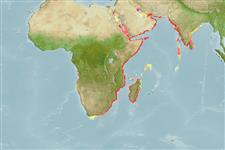Actinopterygii (ray-finned fishes) >
Clupeiformes (Herrings) >
Engraulidae (Anchovies) > Coiliinae
Etymology: Thryssa: Greek, thrissa, -es = shad (Ref. 45335).
Environment / Climate / Range
Ecology
Marine; brackish; pelagic-neritic; depth range 0 - 50 m (Ref. 189). Tropical, preferred ?; 31°N - 40°S, 20°W - 88°E (Ref. 189)
Indian Ocean: Madagascar, coasts of Africa from Port Alfred northward to the Persian Gulf but not in the Red Sea, coasts of Pakistan and India, perhaps to Calcutta and off Myanmar, but no records.
Size / Weight / Age
Maturity: Lm ? range ? - ? cm
Max length : 20.0 cm TL male/unsexed; (Ref. 5430)
Dorsal
spines
(total): 0;
Anal
spines: 0;
Anal
soft rays: 31 - 40. Belly with 16 to 19 + 8 t0 12 = 24 to 30 keeled scutes from isthmus to anus. Maxilla long, reaching beyond base of first pectoral fin ray; minute, oval first supra-maxilla. Lower gill rakers with serrae on the inner edge in distinct clumps in larger fishes. A dark blotch behind upper part of gill opening; inside of gill cavity bright orange.
Coastal pelagic (Ref. 68964). Presumably schooling, occurring inshore and entering estuaries and lagoons (perhaps as nursery areas), but moving further out in rainy seasons when coastal waters are freshened up by rivers. May be caught using ringnets (Ref. 5213). Generally marketed fresh, may be salted or dried (Ref. 5284).
Life cycle and mating behavior
Maturity | Reproduction | Spawning | Eggs | Fecundity | Larvae
Whitehead, P.J.P., G.J. Nelson and T. Wongratana, 1988. FAO Species Catalogue. Vol. 7. Clupeoid fishes of the world (Suborder Clupeoidei). An annotated and illustrated catalogue of the herrings, sardines, pilchards, sprats, shads, anchovies and wolf-herrings. FAO Fish. Synop. 125(7/2):305-579. Rome: FAO. (Ref. 189)
IUCN Red List Status (Ref. 115185)
CITES (Ref. 94142)
Not Evaluated
Threat to humans
Harmless
Human uses
Fisheries: minor commercial; bait: usually
More information
ReferencesAquacultureAquaculture profileStrainsGeneticsAllele frequenciesHeritabilityDiseasesProcessingMass conversion
Tools
Special reports
Download XML
Internet sources
